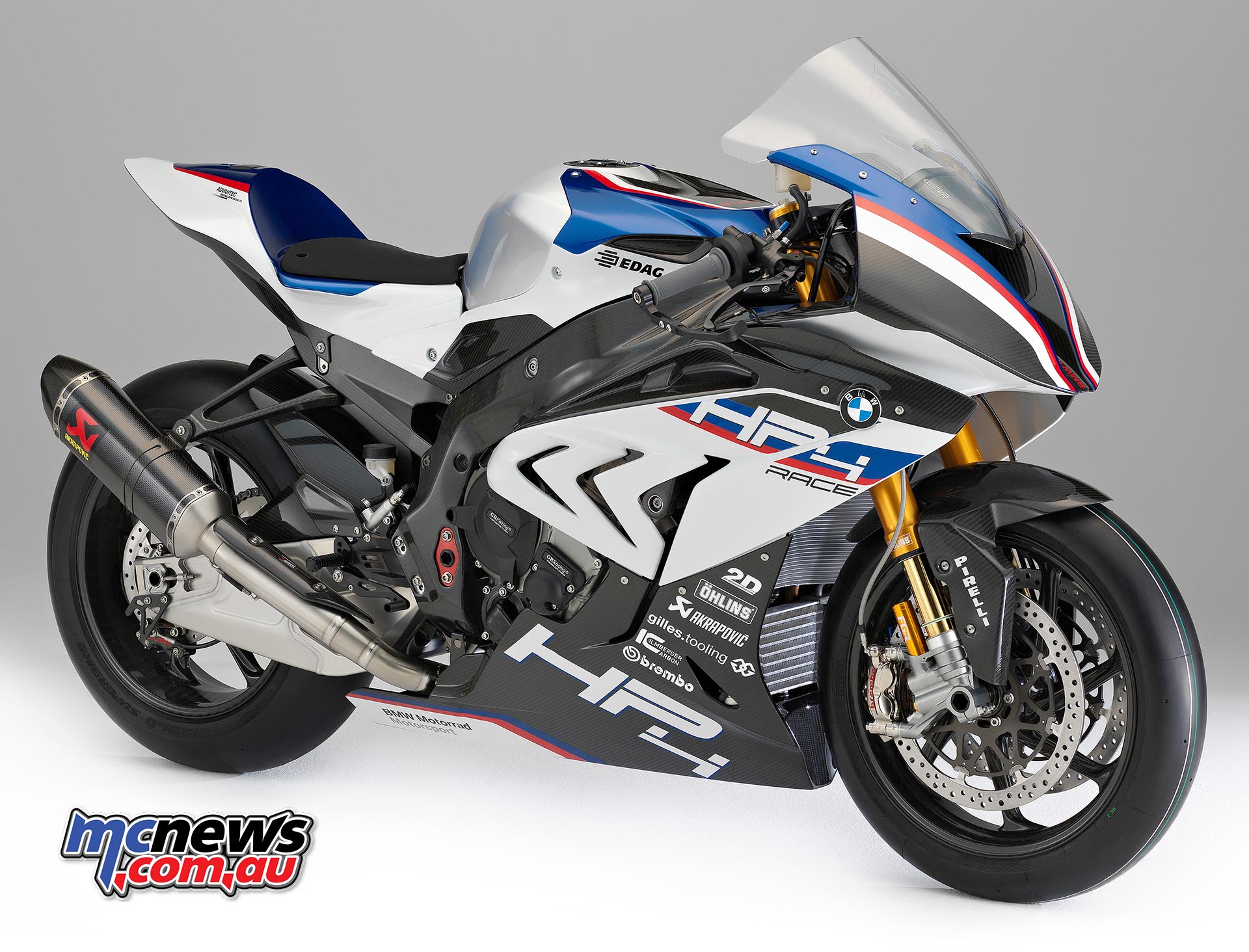The Barber Vintage Motorsports Museum Part 6 – With Phil Aynsley
Part six of a tour through the Barber Museum – European machinery
Back to Part 1 – Back to Part 2 – Back to Part 3 – Back to Part 4 | Back to Part 5
In this column I concentrate on European machinery on view in the Barber Museum.
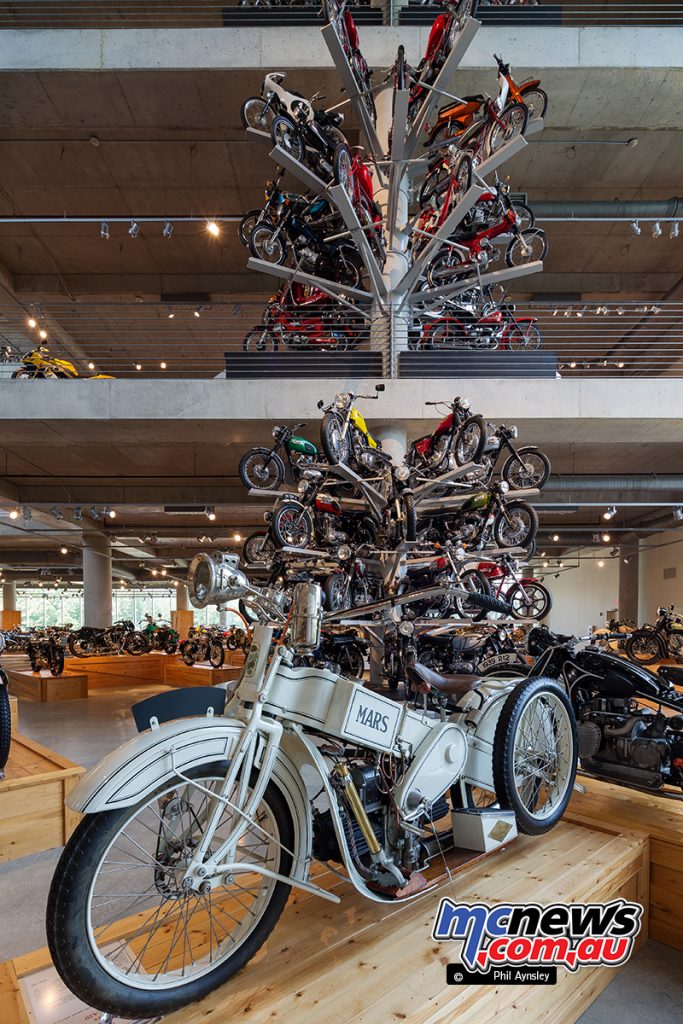

Known as the “White Mars” (although small numbers were also available in red and green) this is one of the best examples still in existence – complete with lights, speedometer and spare wheel.
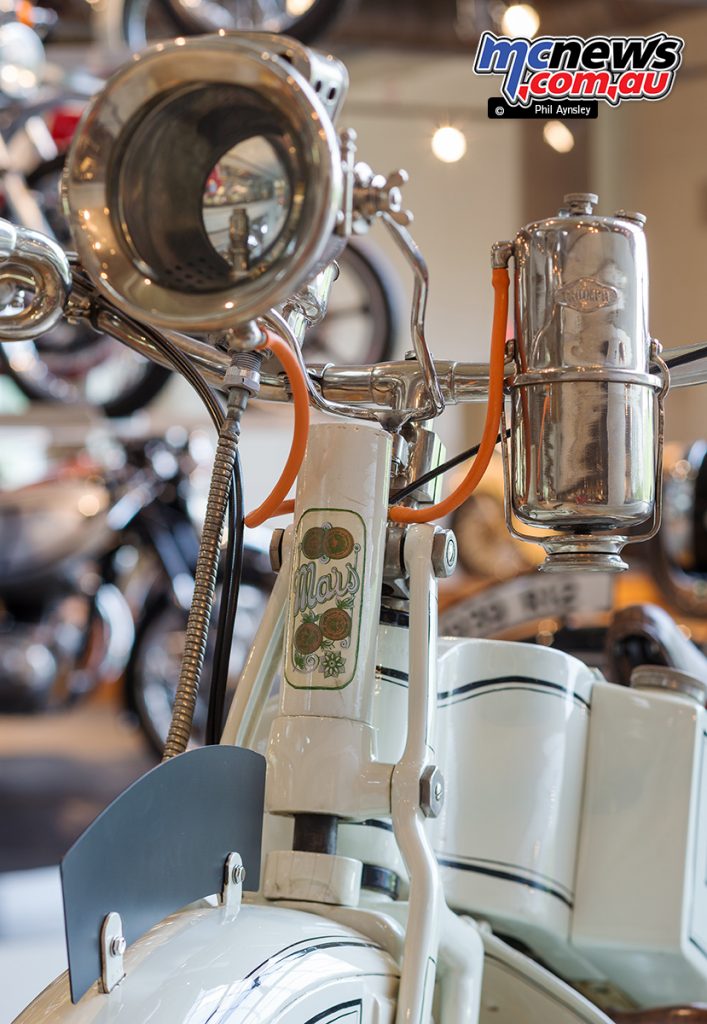
Mars was founded in Nuremberg in 1873 and produced stoves, grinding machines, bicycles, and in 1903, motorcycles (cars were briefly made from 1906 to ’08). The A20 was its most famous product however and was introduced in 1920.
Designed by Claus Franzenburg it featured a 956cc horizontally opposed twin manufactured exclusively for Mars by Maybach. Distinctively the engine was mounted longitudinally. At first a two-speed, twin chain transmission was fitted but this was soon replaced by a conventional three-speed gearbox. Starting was by hand crank.
The frame was unusual in being a box-section steel sheet design that was both welded and riveted together with the engine supported below on a subframe. A trailing link front fork was used. The A20 was built until 1925 when an economic downturn caused the company to cease production.
In 1928 two former employees started things up again under the MA name and the company continued making various types of motorcycles up until 1958.
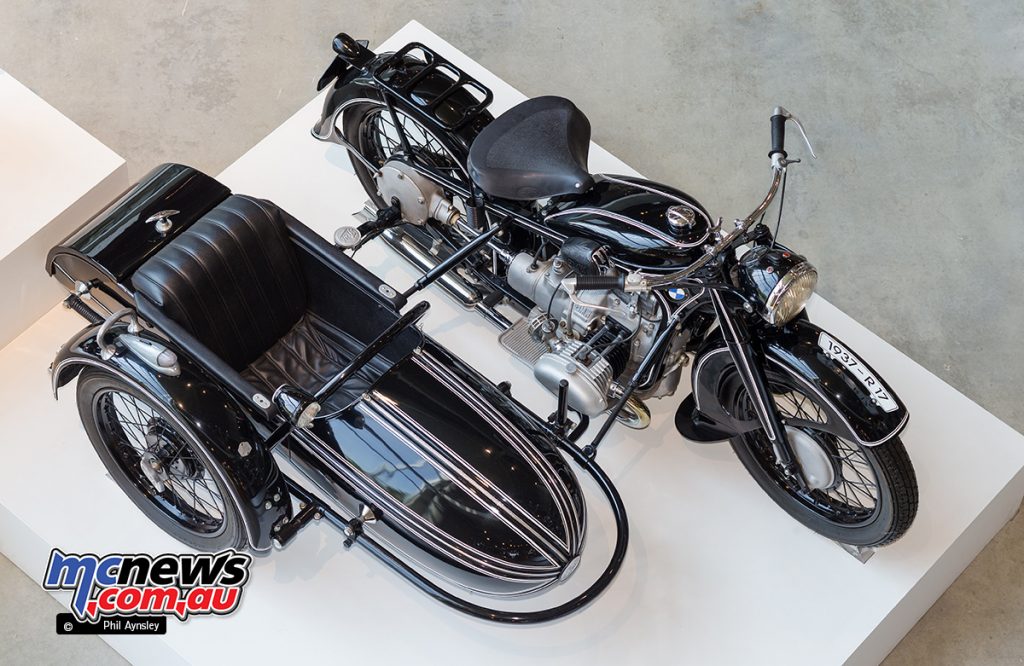
1937 BMW R17 and sidecar.
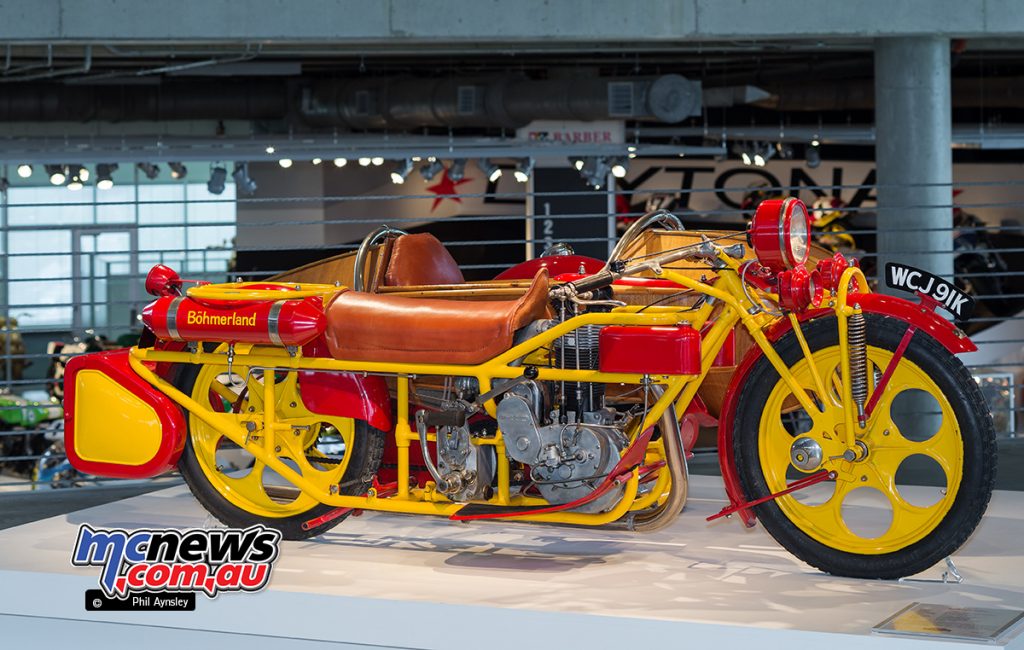
1925 Böhmerland. The Czech Böhmerland is one of the more unusual motorcycles to ever be mass produced. Some 3000 were built between 1924 and 1939 in a variety of models ranging from the two-seat Sport through to the 4-seat Langtouren with a 3.2m wheelbase.
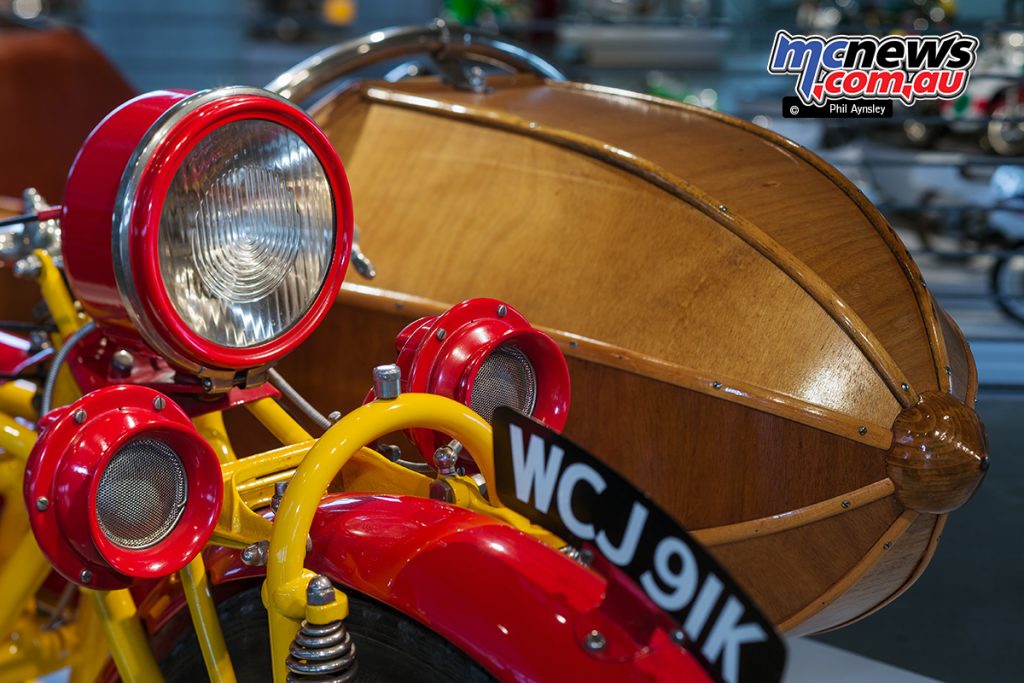
One advanced feature was the use of light alloy cast wheels. The 600cc single made 20hp at 3,500rpm. This 1925 bike is the oldest example known to have survived.
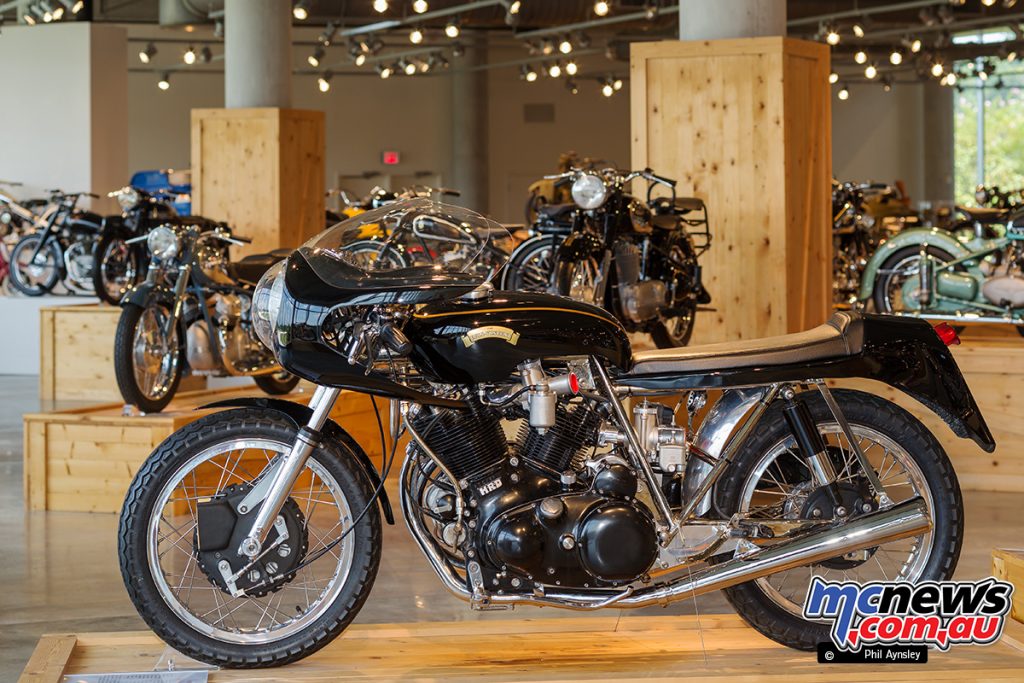
1968 Egli-Vincent 998.

All the main flavours of road-going MV fours! The rare, with only 50 built, 1973 750 GT (left) was a major improvement over the original 1967 600/4, of which 127 were made (right).
A 1972 750 Sport fitted with the optional full fairing sits above a 1977 750S America, which was the final major version of the classic MV four (and actually 789cc).
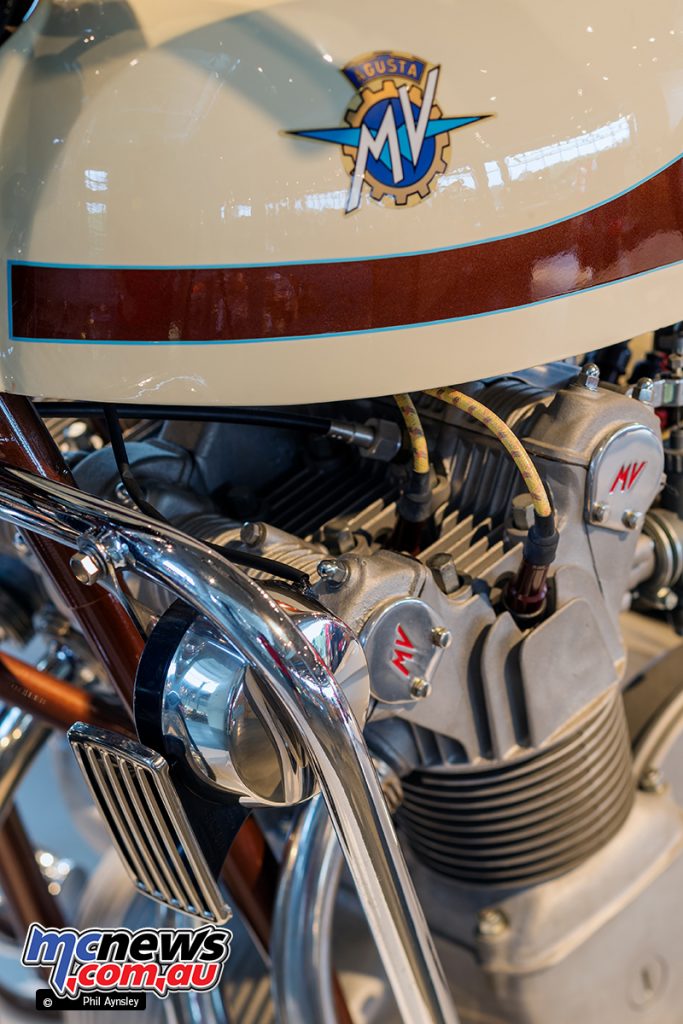
With only 50 made, the MV Agusta 750 GT was a rare and expensive (three times the price of a Honda CB750) beast. The Australian importer, Bob Jane, only sold about three. 68hp at 8,450rpm. Top speed 190km/h.

1971 MV Agusta 250B. Based on the 166cc Arno GT, the 250 B twin was an especially clean design with no external oil lines. Power was 19hp at 7,800rpm and top speed was 130km/h.

1970 American Eagle 150 Renegade. John McCormack set up the American Eagle brand in 1966 after previously working for the US arms of Honda and Suzuki. The parent company McCormack International imported various Italjet, Laverda and Kawasaki models and sold them under the American Eagle name.
The Renegade used the Laverda 125 Trail as the base but it was fitted with a 150cc motor and used Californian designed UNICON fibreglass bodywork.

The world’s first mass produced rotary powered motorcycle debuted at the Cologne Show in 1970. The German company Fichel & Sachs had a license to build the Wankel design and through their DKW subsidiary produced this 294cc single rotor bike in 1974-5.
It was marketed as a DKW in the UK but as a Hercules (another old German brand owned by Sachs) everywhere else. Less than 2000, including an enduro version, were produced, with 27hp at 6,000rpm and a top speed of 150km/h.
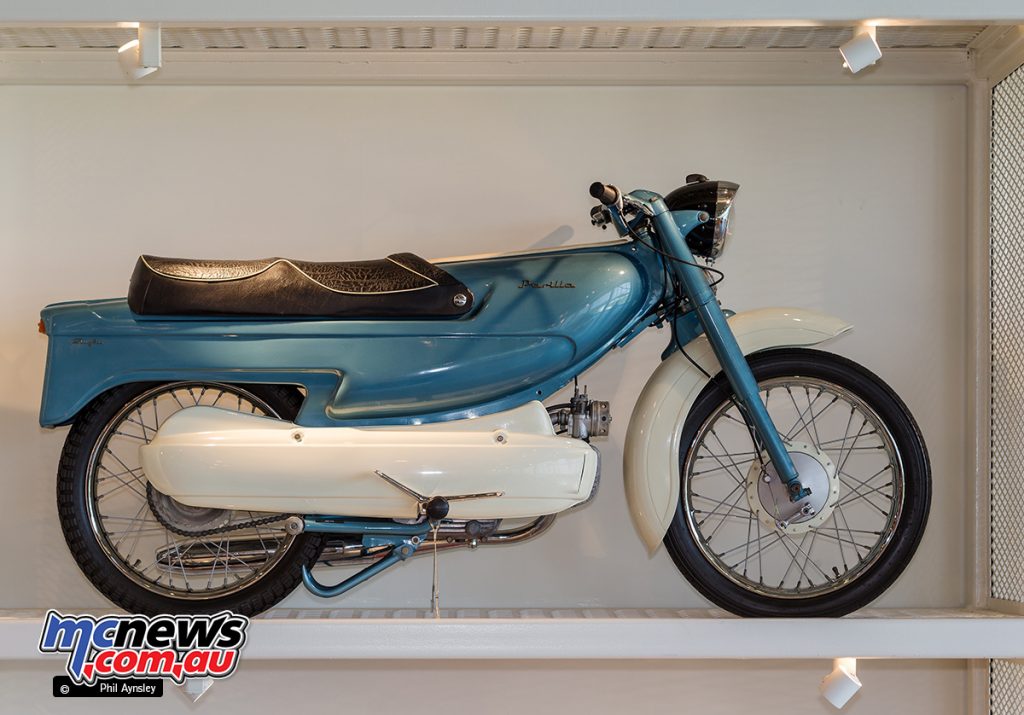
1959 Parilla Slughi 125. The Slughi (Desert Greyhound) was first shown at the Milan Show in 1957 with production commencing the following year. It was available with either a 125cc two-stroke, or 99 and 125cc OHV four-stroke motors.
Sales were disappointing however and production ended in 1964. In the US they were imported by Cosmo Motors and sold under the Ramjet (or Ramjet Streamliner) name.
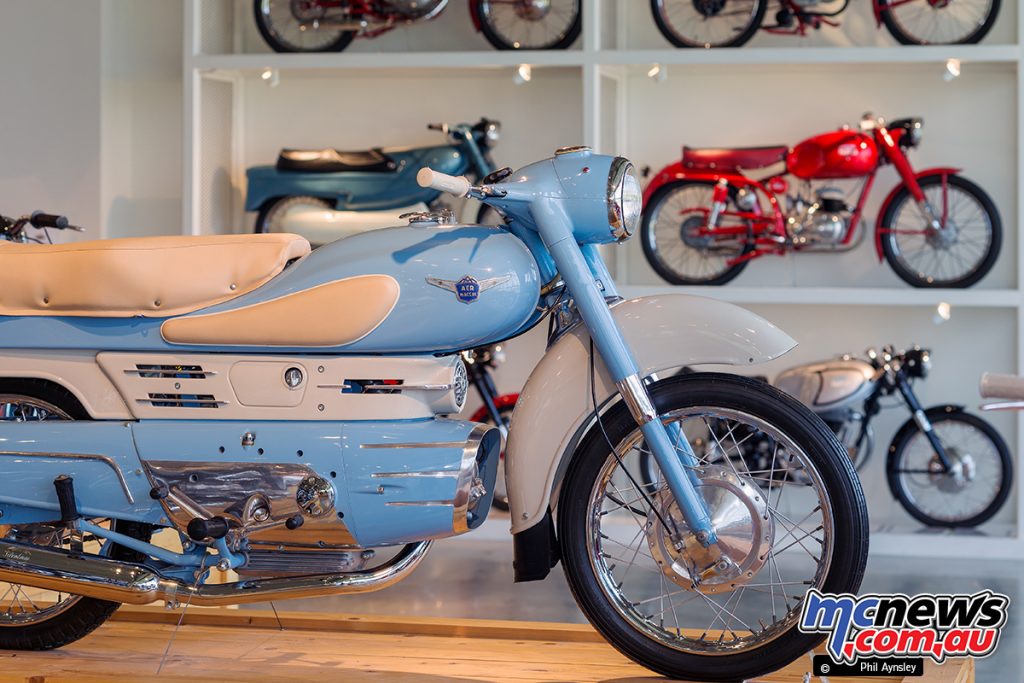
1960 Aermacchi 175 Chimera. The Chimera (Dream) was Aermacchi’s first 4-stroke design and created by the company’s new technical director Ing. Alfredo Bianchi. The original concept was from a sketch of the “ideal motorcycle” by noted car stylist Count Mario Revelli.
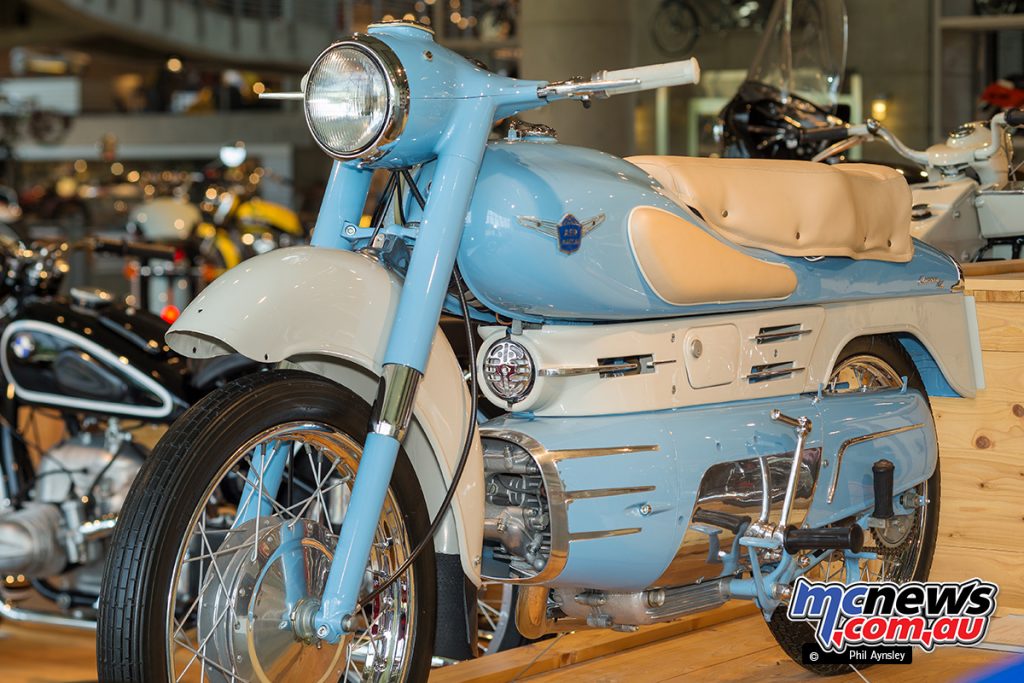
First shown in late 1956 the bike featured bodywork made from die cast alloy and steel pressings. The 175 entered production in 1958 but only 119 were made before production ceased in 1961. A 250cc version was also built from 1958 to 1964, with 177 made. The 175 made 13hp, weighed 144kg and had a top speed of 105km/h.
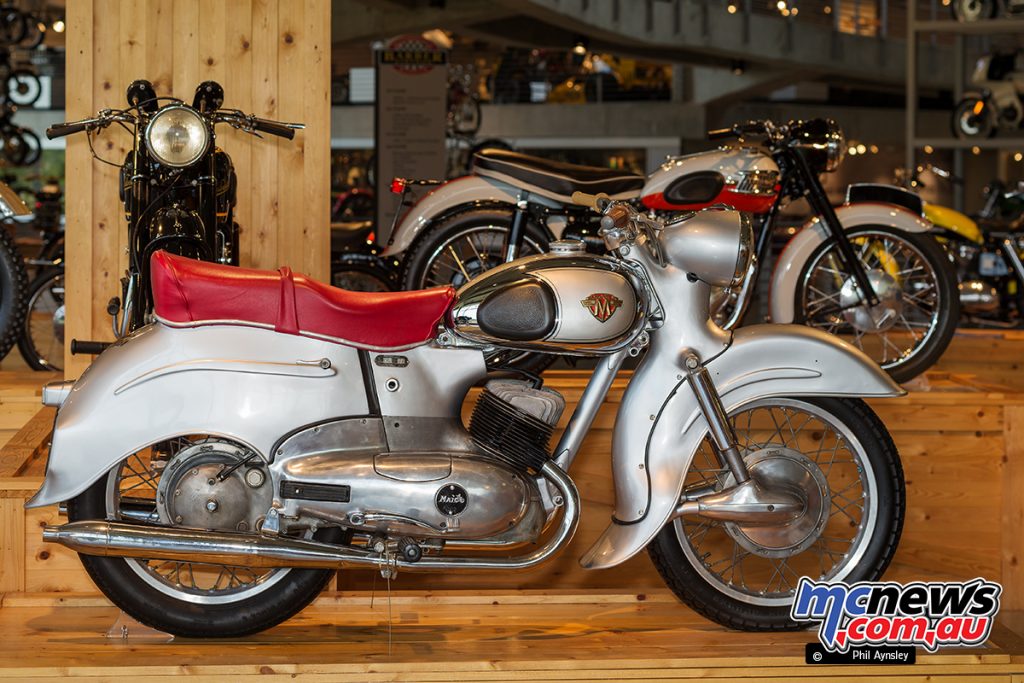
1954 Maico 400 Taifun.

1948 Imme R100. The R100 is a wonderful example of both innovative and beautiful design. Norbert Riedel was an engineer for the German motorcycle manufacturer Ardie before WW II, then working for Victoria-Werke, was responsible for the design of the small (270cc), horizontally opposed twin cylinder two-stroke starter motor that was fitted to the BMW 003 and Junkers Jumo 004 turbojet engines used by such aircraft as the Me 262 and Ar 234.
In 1947 Riedel set up his own company to produce his R100 motorcycle which was intended to provide a basic means of transportation for post war Germany. The 99cc two-stroke made 4.4hp at 5800rpm – about twice that of the competition at the time, and cost a modest 775DM.
Thoughtful features abounded such as the use of the same diameter steel tube for the frame, front fork and swingarm (which did double duty as the exhaust pipe). The use of single-sided suspension, front and rear, halved the amount of material required. The attractive power unit had the carburettor behind the right hand engine cover and a three speed gearbox.
It also used a single main bearing design that proved to be the ultimate downfall of the company, as while it saved production costs, it proved to be unreliable and warranty repair costs became crippling, despite a redesign to a twin bearing design during production. In all over 12,000 R100s and its variations were built before the company folded in 1951.

1953 Victoria Bergmeister 350. Victoria originally built bicycles before starting motorcycle production in 1901, continuing until 1966. The Richard Küchen designed V35 Bergmeister was first shown in 1951 with production starting in 1953 and was an eye-catching motorcycle.
The streamlined 350cc OHV transversely mounted V-twin engine used an enclosed carburetor, a chain-driven four speed gearbox and a shaft final drive. Around 5000 were built over three years and the design certainly inspired the Japanese Lilac. 21hp at 6350rpm. Top speed 130km/h. This one of the first motorcycles collected by George Barber.
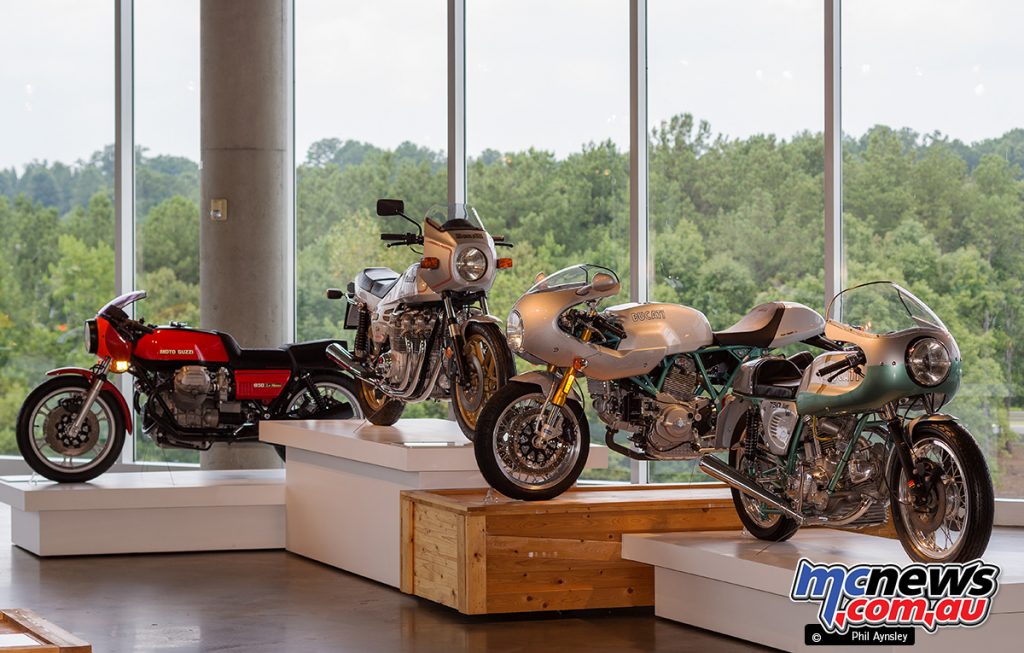
Left to right: 1978 Moto Guzzi 850 LeMans MkI. 1983 Benelli 900 Sei. 2006 Ducati Paul Smart 1000LE. 1974 Ducati 750SS.

Produced between 1976-78 the Moto Guzzi 850 Le Mans is commonly referred to as the Mark I. Produced in two batches, this is a Series 2 model with the rectangular tail light design. 71hp at 7300rpm gave a top speed of 200km/h.
The Benelli Sei was a development of the 1974 750 six. Less than 2000 of the 900cc version were produced. Power was 80hp at 8400rpm, with a top speed of 210km/h.
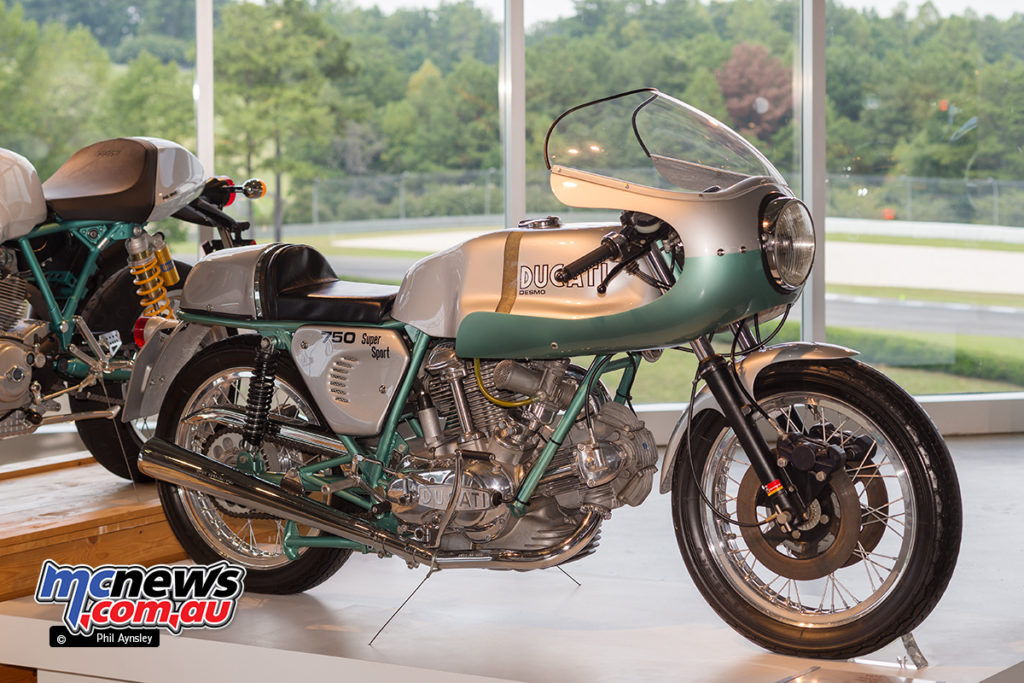
1974 Ducati 750SS. The fabled 1974 Ducati 750 SS, also known as the Greenframe. It was the first production motorcycle to use triple disc brakes and come equipped with a half fairing. It was the first Ducati twin cylinder road bike to use Desmo valve operation. The going rate for a good example – well over US$150,000. 65hp at 8500rpm. Top speed 220km/h.

1965 Ducati 160 Monza Jnr. The museum is laid out grouping bikes in a series of themes. Here a humble 1965 Ducati 160 Monza introduces the ‘60s. 8hp at 7500rpm. Top speed 110km/h.
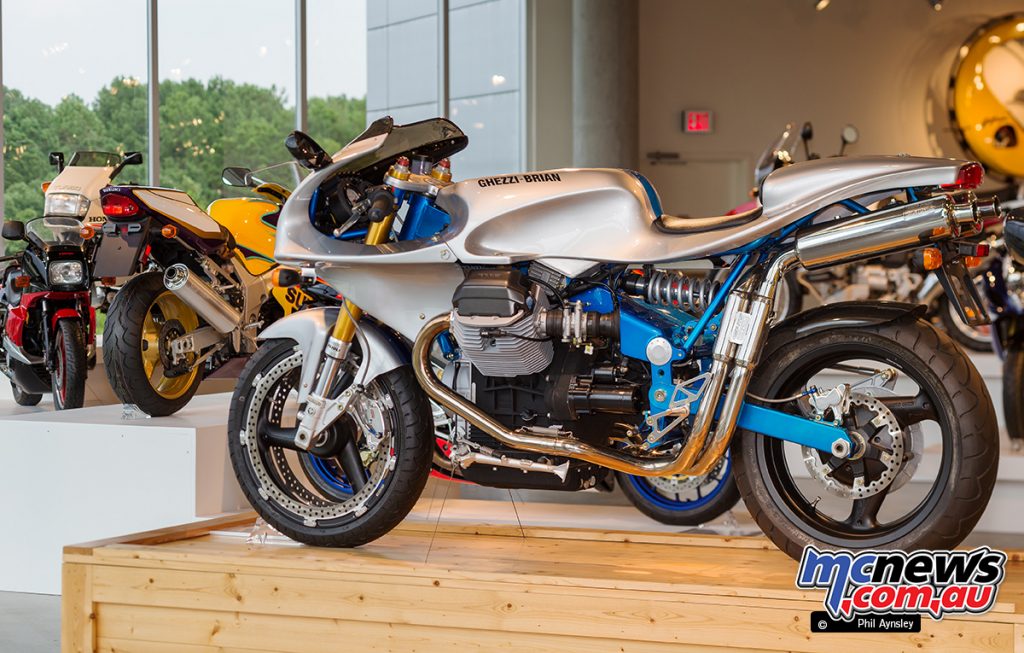
2002 Ghezzi & Brian Super Twin 1100. Italians Giuseppe Ghezzi & Bruno Saturno operate a company dedicated to modifying Moto Guzzis.
One of their bikes won the 1996 Italian SuperTwin championship and the road going 1100 was produced in limited numbers as a result of the subsequent demand. It is over 45kg lighter than the stock equivalent. 94hp at 8,000rpm. Top speed 240km/h.

1988 Ducati 750 Paso on the left. The 1986 750 Paso was the first all-new model to come from Ducati after the Cagiva take over in 1985. With fully enclosed bodywork and automotive-style Weber carburettor by designer Massimo Tamburini it was a radical departure from previous Ducatis.
Named after the great Italian racer Renzo Pasolini, the 750 was produced until 1988, after which the 906 (and later, 907) model took over. 72hp at 8,000rpm. Top speed 210km/h. Right is the 2002 Ghezzi & Brian Super Twin 1100.

1979 Laverda 1200 30th Anniversary. One of the rarest Laverda models produced, this 1979 1200 30th Anniversary came with a personalised letter from Massimo Laverda. It was the first Laverda fitted with a hydraulic clutch and used some Jota engine parts.
The black and gold colour scheme extended to the steering nut being plated in real gold. While Laverda proposed to build 200 only 29 were actually offered for sale, with 10 coming to Australia (four were sent on to NZ). The rest of the production went to the Libyian Police Force! 85hp at 7500rpm gave a top speed of 225km/h.

1971 Munch4 1200 TTS. Fridel Münch worked for Horex in their race department up until the company ceased motorcycle production in 1956. After building his own Horex based cafe racers he turned (in 1966) to using the 996cc NSU four cylinder car engine fitted to a frame of his own design.
Originally called the Mammut (Mammoth) that name was soon dropped due to copyright reasons. Two years later the definitive Münch4 1200TTS version was released powered by a larger 1177cc NSU motor.
This made 88hp at 6000rpm and combined with the bike’s weight of 298kg, caused Münch to design a cast magnesium rear wheel to eliminate spoke failures. Magnesium was also used for the seat base, headlight binnacle and brakes. The tank was hand beaten aluminium. Less than 500 were constructed up until 1975 – this is a 1971 model.
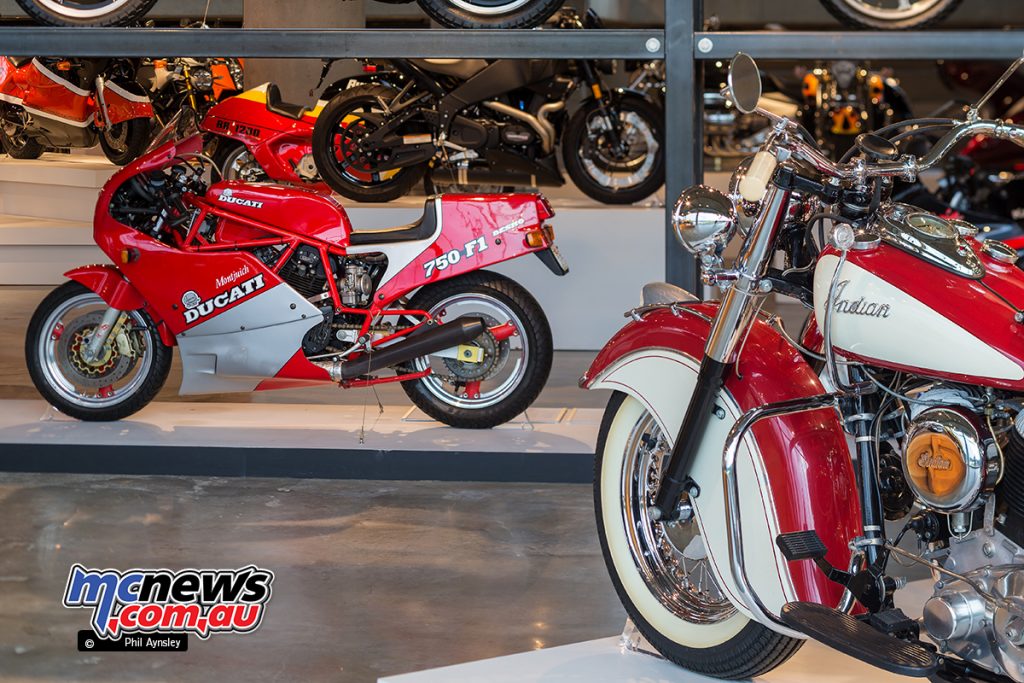
1986 Ducati 750 Montjuich.
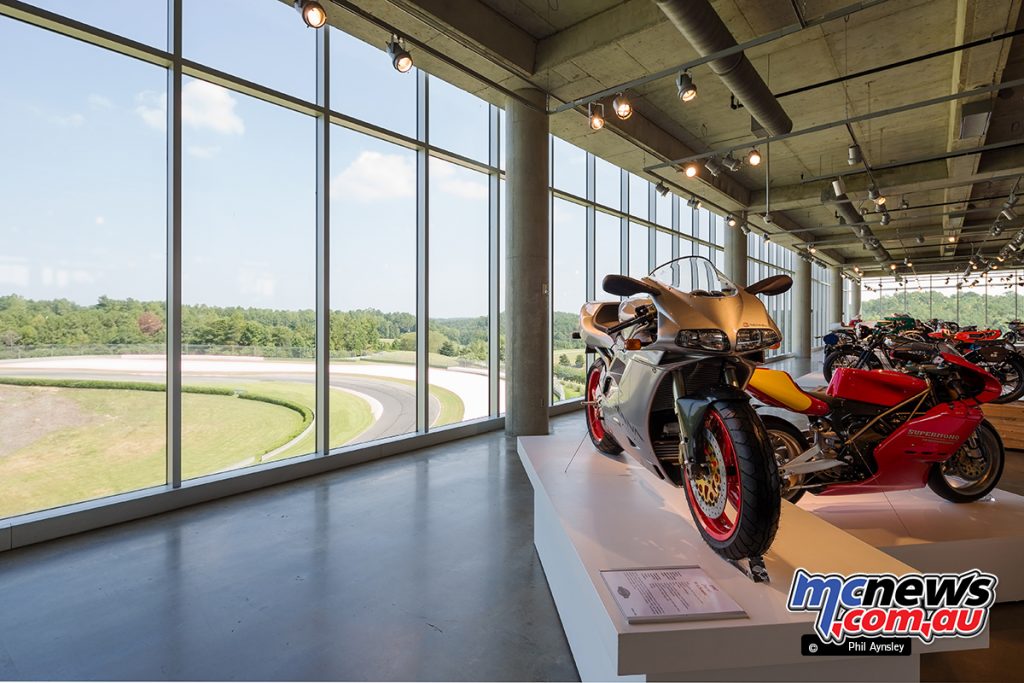
Overlooking a section of the racetrack. Ducati built three editions of the 916 Senna, in 1995, 1997 and 1998. This the ’97 Senna II. Total production was 1000 units with 109hp at 9000rpm.
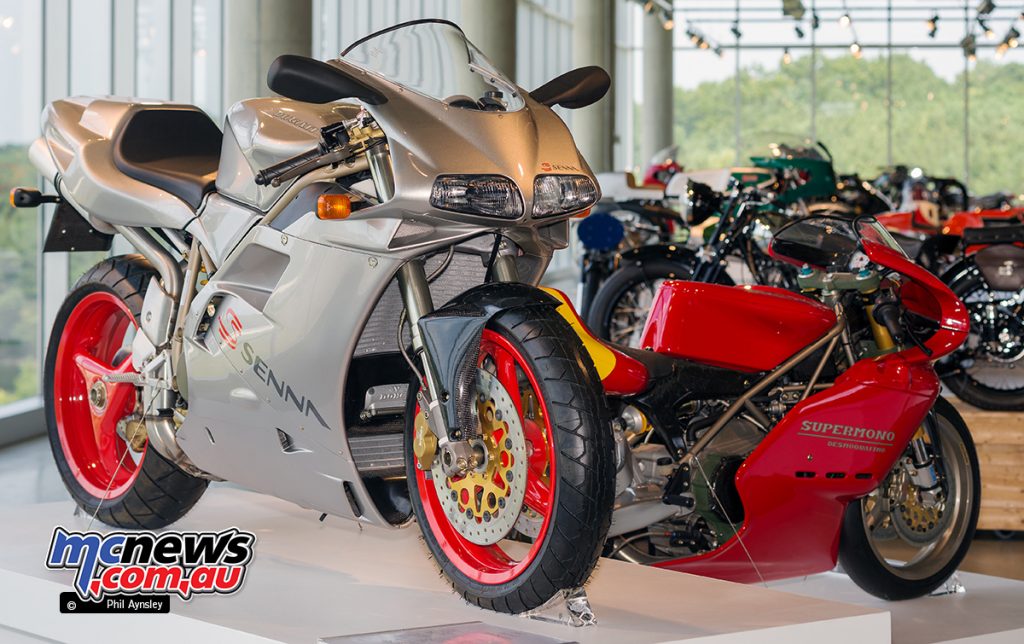
One of the most desirable Ducatis ever produced is the Supermono. This full on race bike was built in two versions, the 1993/4 550cc (seen here) and the 1995 572cc, for a total of 67 bikes. 78hp at 10,500rpm. Top speed 240km/h.
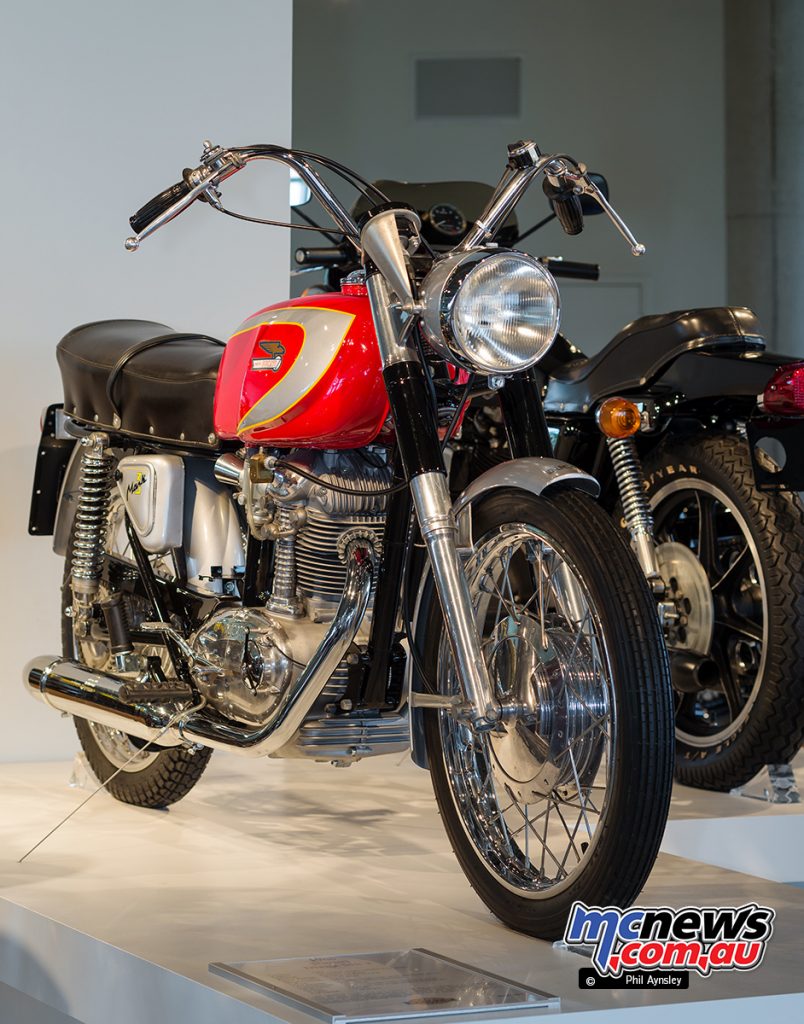
1966 Ducati Diana 250 Mk3. The 5-speed Ducati 250 Mk 3 made a big impression in the US. Intended only as a stop gap model for 1965 (between the four-speed Diana and the Mach 1), it ended up being on sale until 1969. It could be ordered with either the high bars seen here or clip-ons. This is a ’66 model. 30hp at 8,000rpm. Top speed 177km/h.
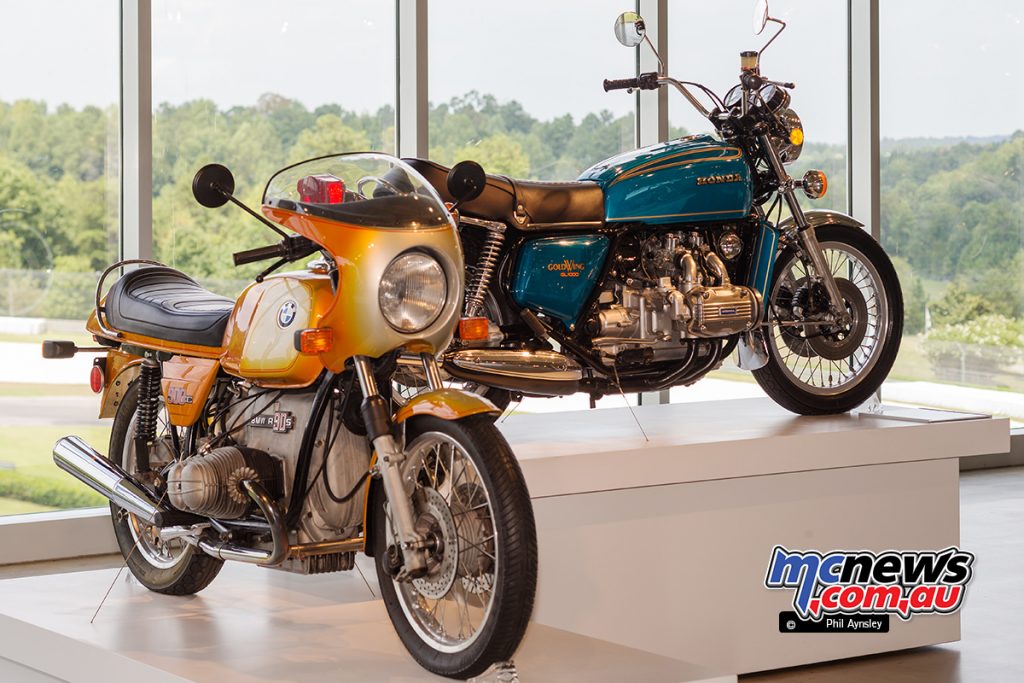
1976 BMW R 90S and 1975 Honda GL1000 Goldwing.

1953 CZ 350GP. Very little is known about this 1953 CZ 350 GP apart from the fact it was designed by Jaroslav Walter – his name is cast into the timing case! Jaroslav worked for his father’s motorcycle company which had been established in Prague about 1900 and produced bikes from 1902.
In 1938 he designed an advanced 250cc OHV racing engine that he later developed into an OHC unit. A 350cc version was introduced in 1947 but the company folded in 1948 after about 50 250/350 engines had been built. The next year he joined CZ who used his design as the basis for their GP racers. 26hp at 5,500rpm. Top speed 115km/h.
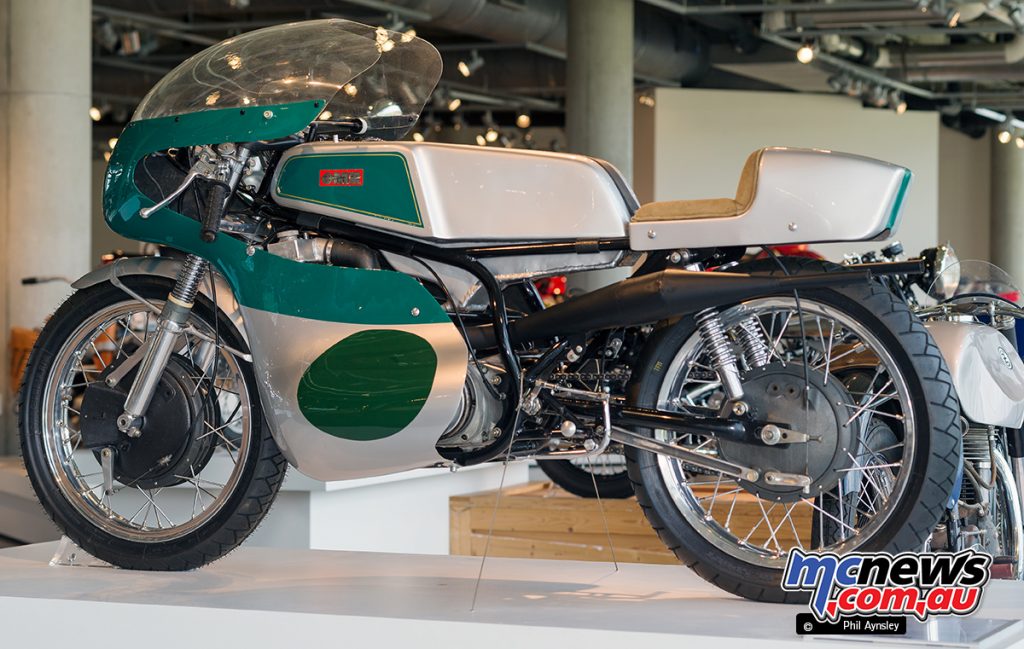
1962 MZ 250/2 GP. The first MZ 250 GP twin made its debut in 1955 and was basically a doubled up version of their 125cc single and made 25hp at 8000rpm.
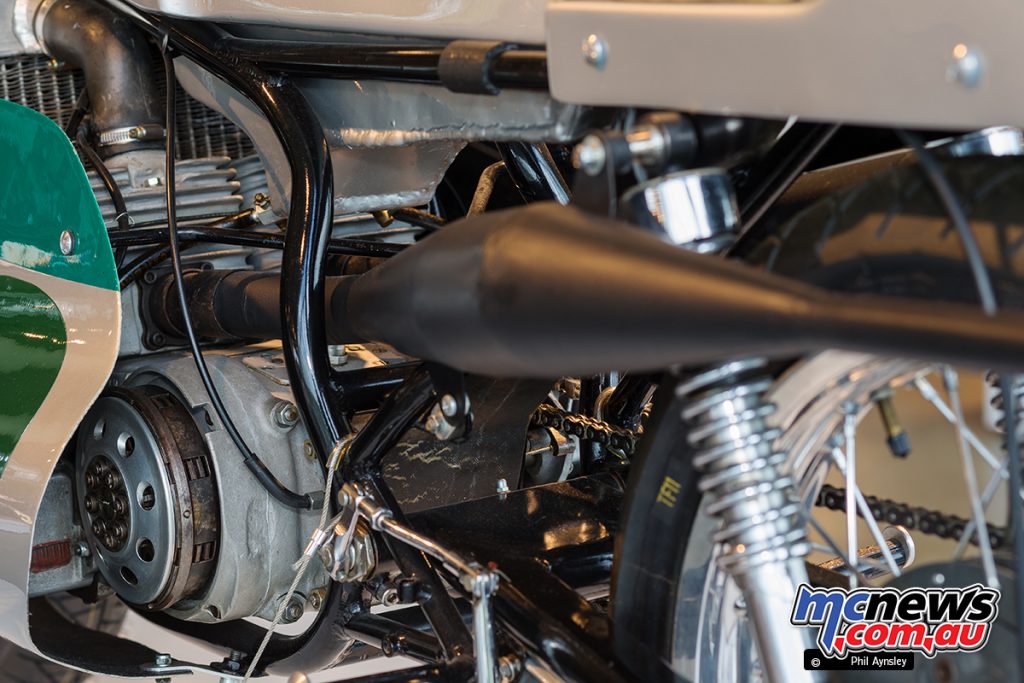
In 1962 the RE250 with water cooling was introduced with 48hp at 11,000rpm. By 1970 it developed 53hp and had a top speed of 225km/h. This is the 1964 version.
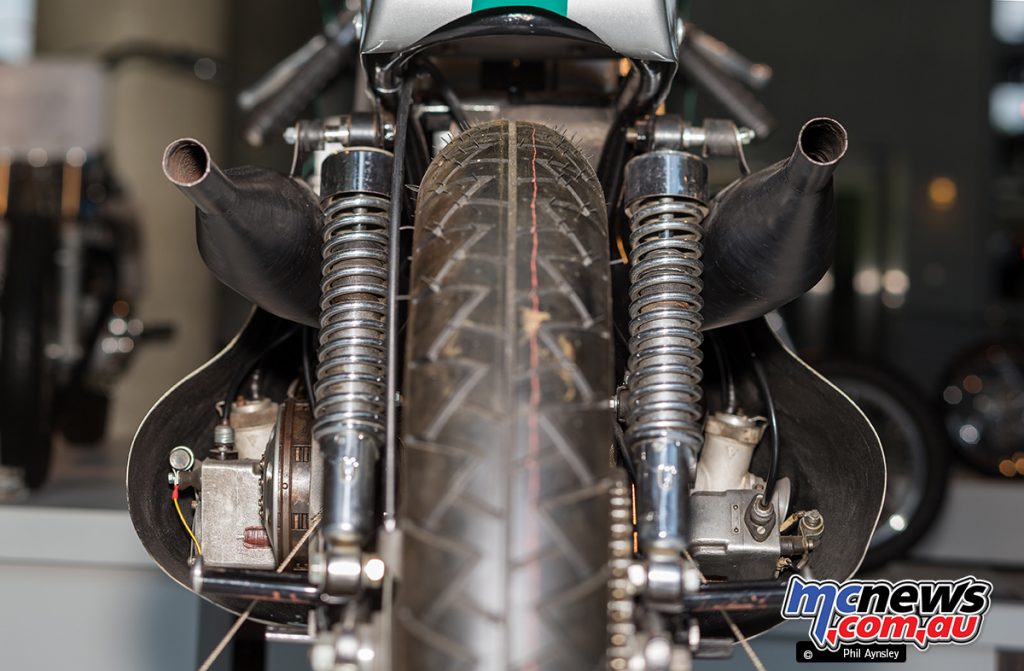
The Walter Kaaden designed bikes were at the forefront of two-stroke development and it was only after the defection of engineer/rider Ernst Degner to the West in 1961 that the Japanese manufacturers, notably Suzuki, became competitive.

1995 Aprilia Moto 6.5 and 1938 Brough-Superior SS100.
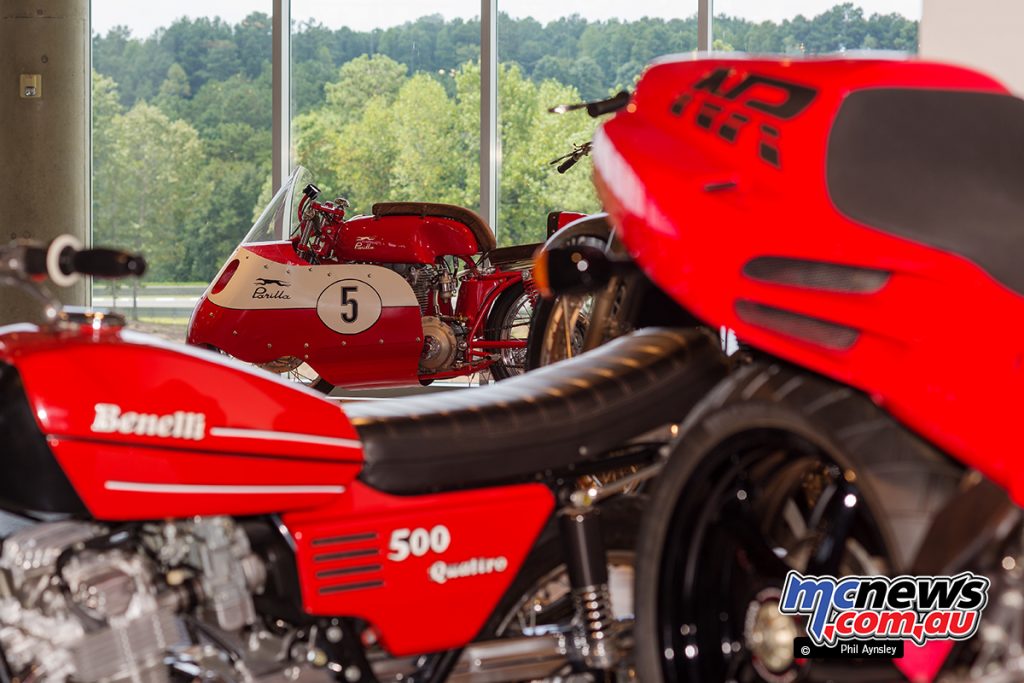
1974 Benelli 500 Quattro and 1997 Honda NR750 in the foreground. Parilla 250 Corsa.
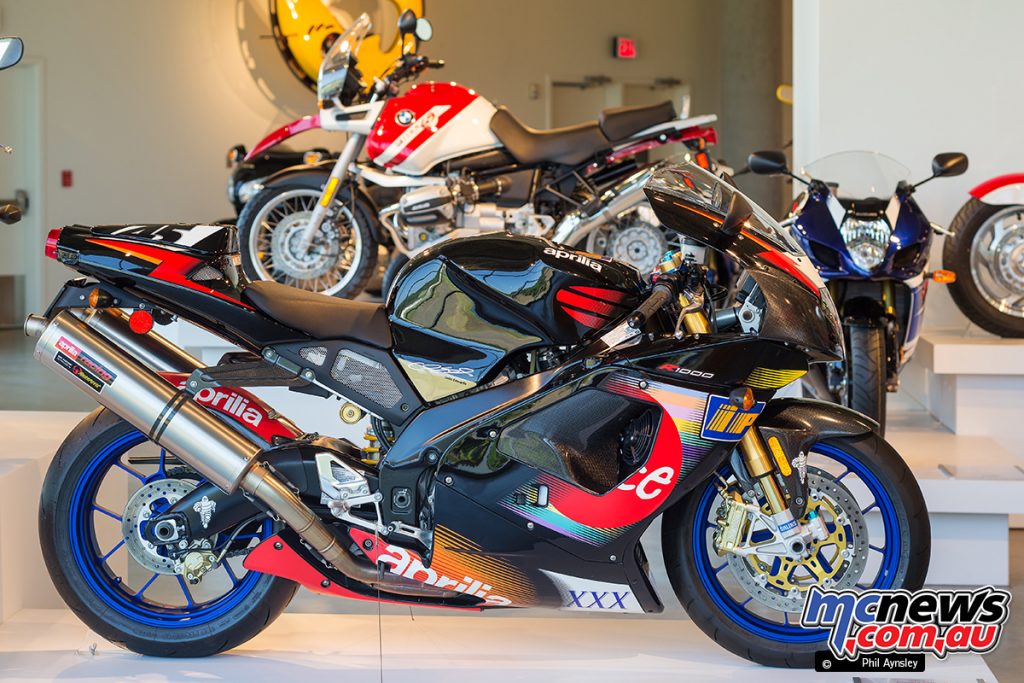
2003 Aprilia Mille-R Colin Edwards Replica.
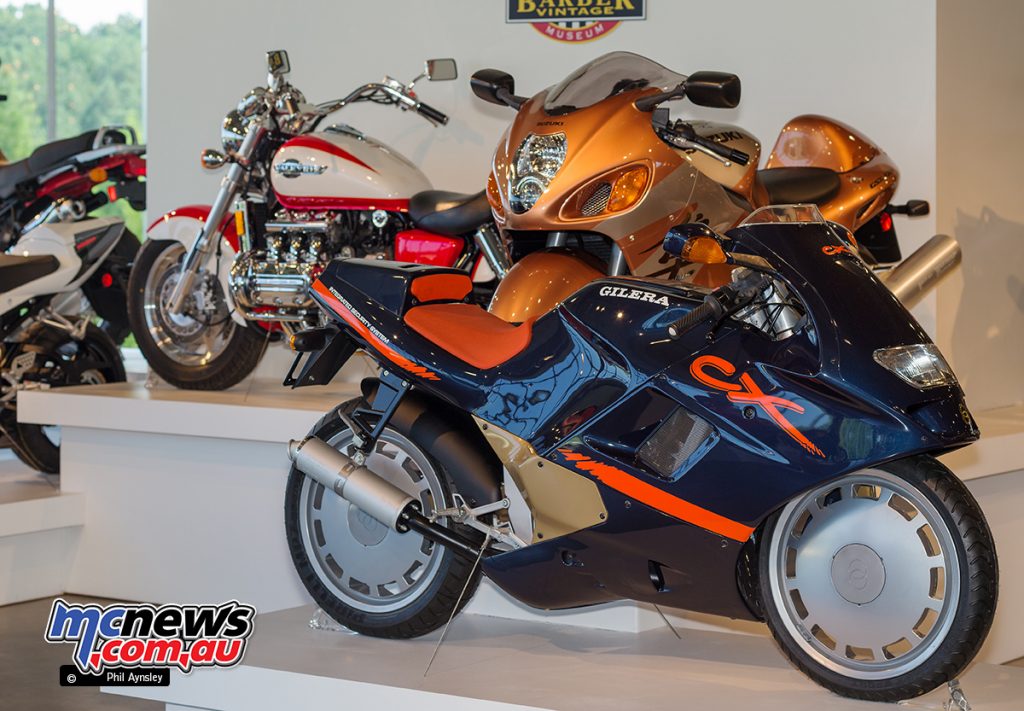
1991 Gilera CX 125.
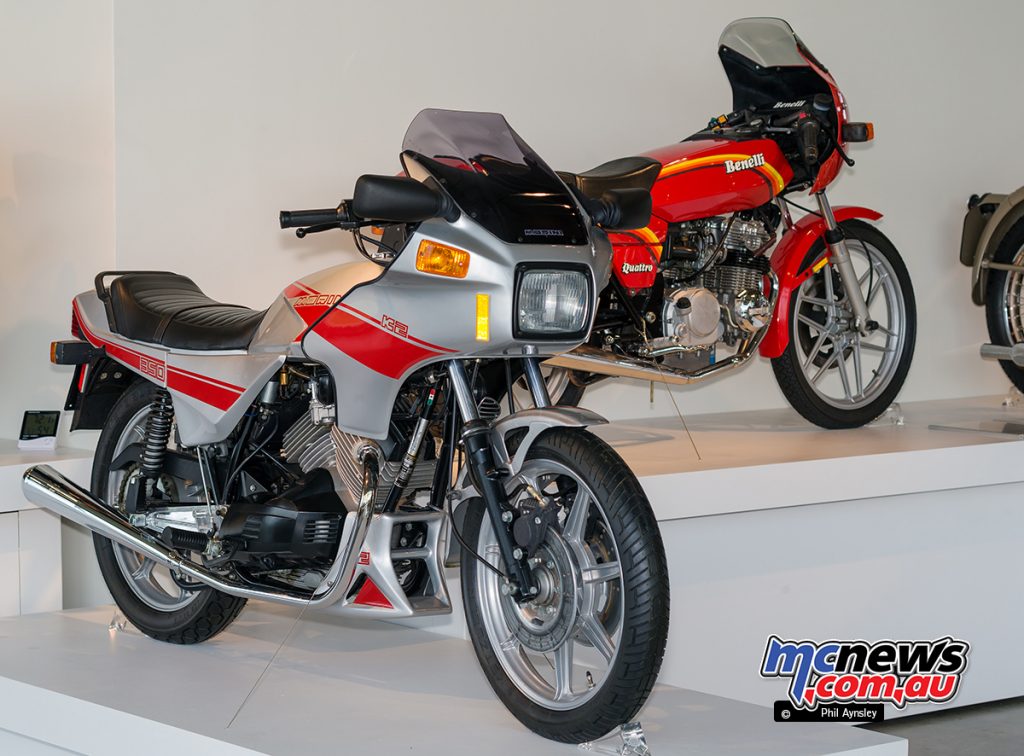
The final version of the Moto Morini 350 before the company came under Caviga’s control in 1987 was the K2 of 1986. While the basics remained the same as the 1973 original, the styling and bodywork was very “Japanese”. 35hp at 8000rpm offered a top speed of 160km/h.
Despite appearances, not a scaled down version of Benelli’s 500/4 (which was very much a Honda copy), the 254 Quattro (and its Moto Guzzi twin) remains the world’s only European four cylinder quarter-litre road bike. Designed by Lino Toni in 1975 the actual capacity was 231cc which gave 28hp at 10,500rpm. This is a 1981 model. Production ceased in 1986.
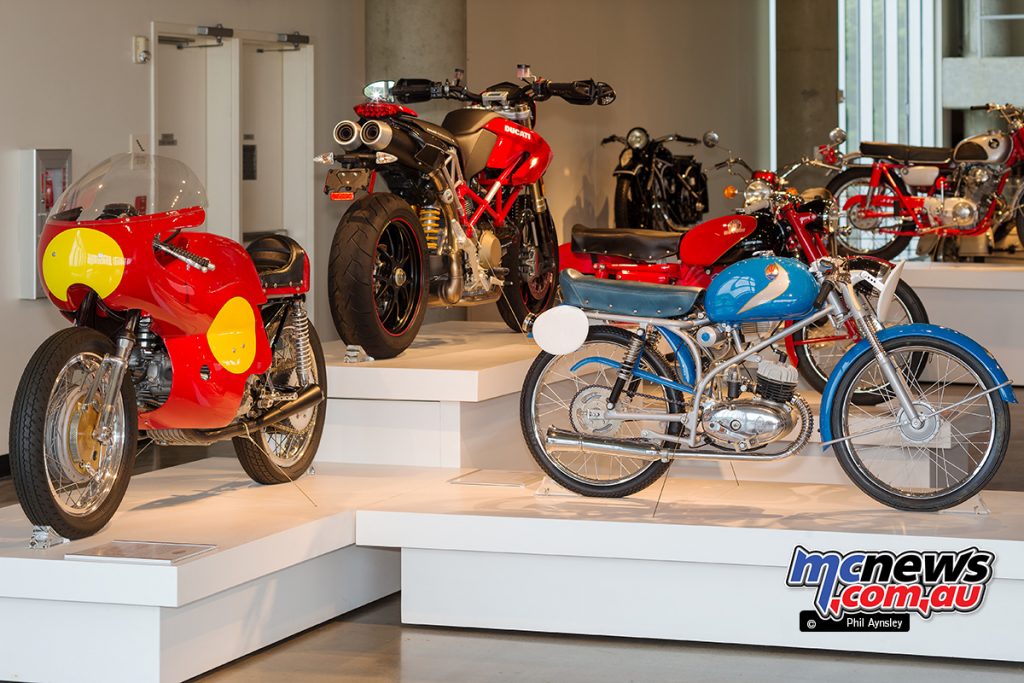
A very varied bunch! Left to right: 1970 Linto 500GP with 68hp at 11,000rpm and a top speed of 230km/h. 2007 Ducati 1100 Hypermotard offering 95hp at 7750rpm, 1957 Motobi Catria Lusso 175 with 8.5hp at 6800rpm and a top speed of 120km/h. 1961 Maserati 50/T2 SS.
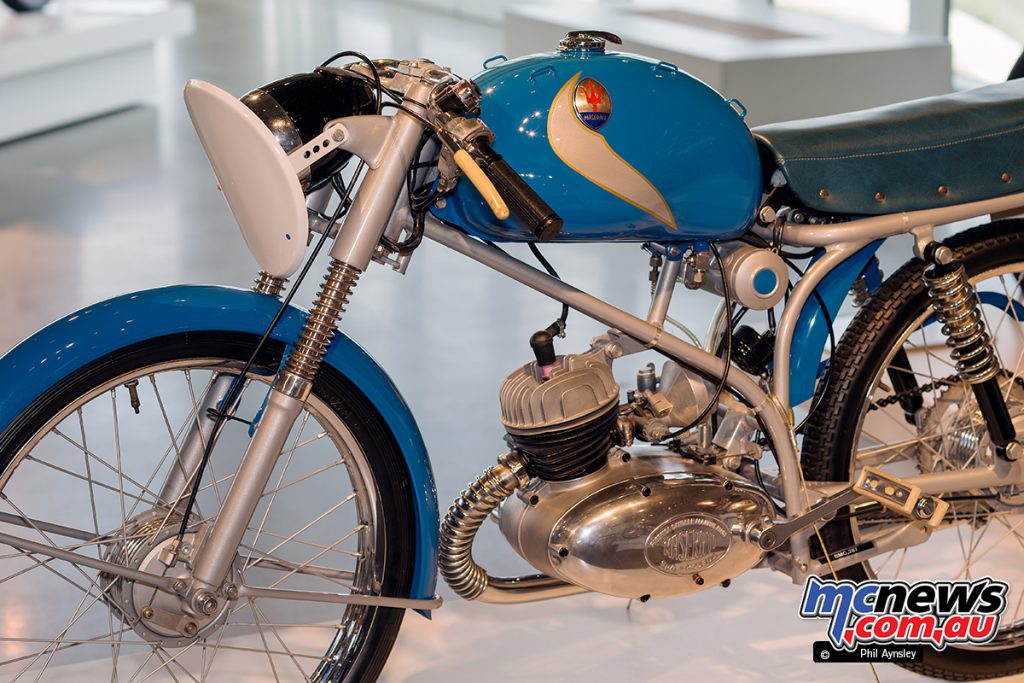
1961 Maserati 50/T2 SS. Built by the Maserati Battery and Spark Plug Company (not the car company) this 50cc two-stroke made 3hp at 6700rpm. Top speed 70km/h.
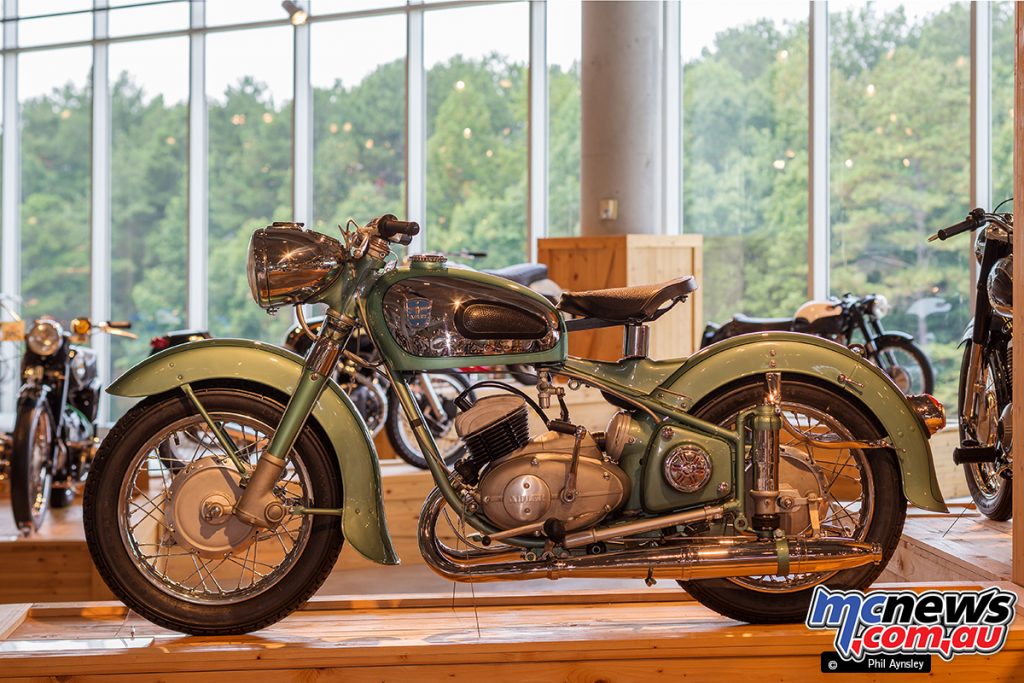
1954 Adler MB 250.
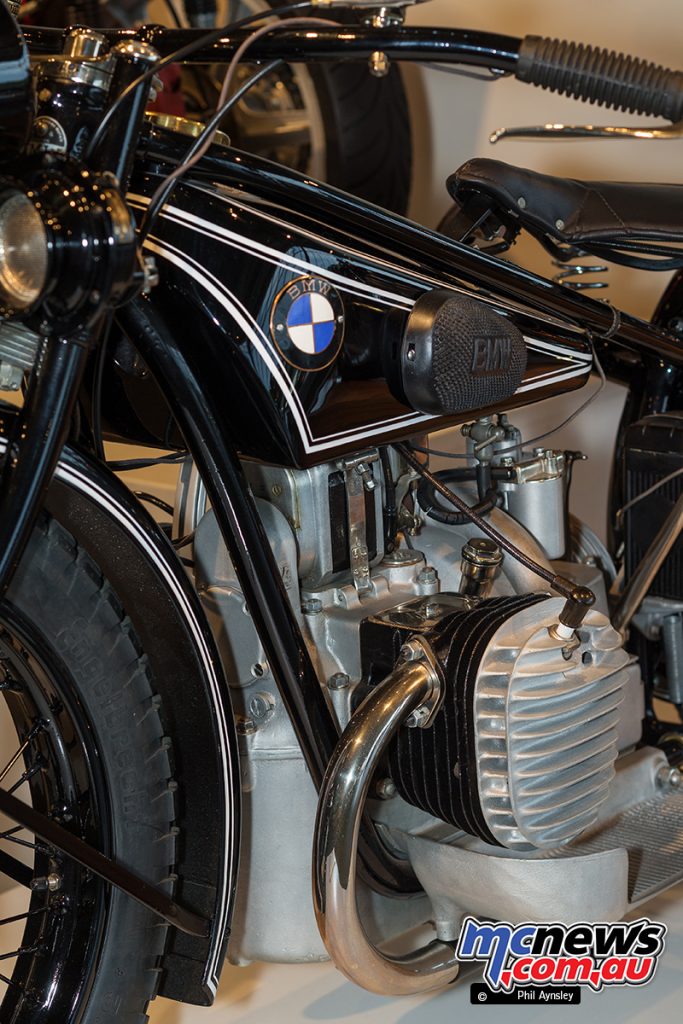
1928 BMW R62.

1956 Parilla 250 Corsa. While Parillas are best known for their “high cam” models, the very first bike built by Giovanni Parrilla (with two r’s) in 1946 was a DOHC design.
He continued to produce a small range of OHC models and the very rare DOHC Corsa race bikes. This 1956 250cc Corsa incorporates magnesium engine cases and brakes. 26hp at 7200rpm gave a top speed 177km/h.





